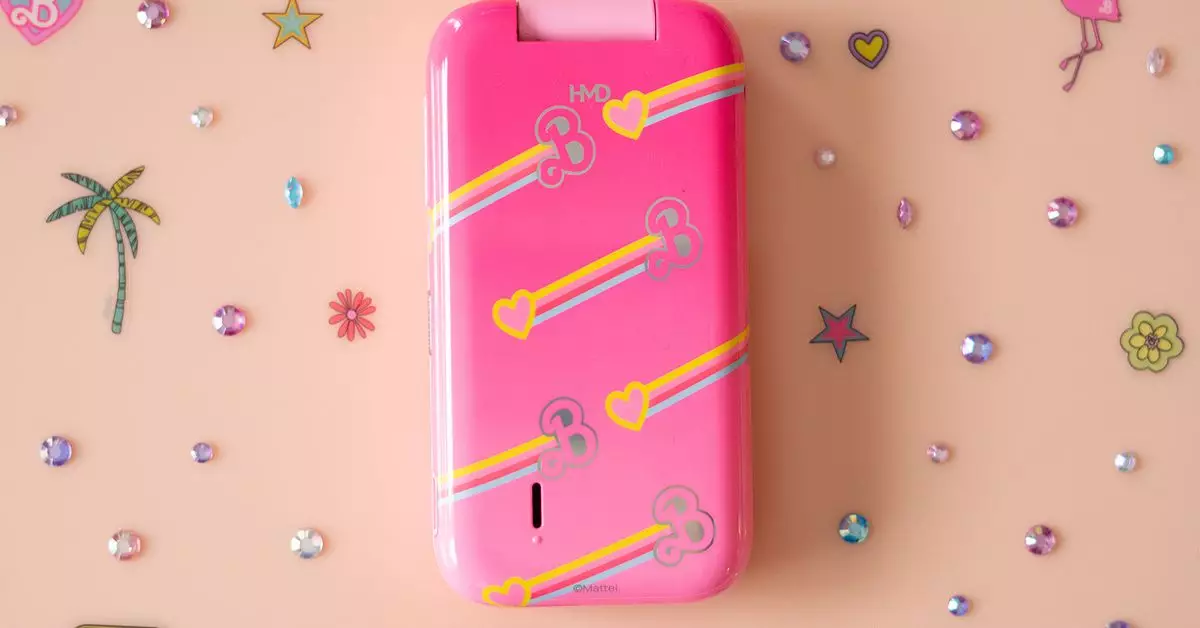In the ever-evolving landscape of technology, there are certain products that evoke nostalgia, often drawing on childhood memories for appeal. The Barbie Phone is one such gadget; it aims to bask in the warm glow of nostalgia while embracing modern aesthetics. However, while the initial allure of the phone may captivate collectors and Barbie enthusiasts alike, a closer examination reveals how impractical it is in today’s hyper-connected world.
From the moment it is unboxed, the Barbie Phone dazzles with its charmingly kitschy design elements. The packaging, adorned with pastel hues and sparkly details, is reminiscent of the iconic Barbie Doll herself. Its lighter shade of pink may not match Mattel’s trademark Pantone 219 exactly, but it certainly captures the playful spirit of Barbie. With interchangeable backplates and a plethora of rhinestone stickers, this phone serves as a striking conversation piece, leaving no doubt about its branding. Users may appreciate its design—a delightful homage to a cultural icon—but beneath this visual charm lies a stark dissonance with practicality.
At its core, the phone operates using KaiOS and serves a limited functionality that mirrors a bygone era of mobile communication, primarily focusing on voice calls and texting. While that might sound refreshing for some, it starkly contrasts with the demands of a modern user seeking comprehensive connectivity. The flip phone’s quirks, such as the whimsical greeting ”Hi Barbie!” each time it powers on, might initially amuse. Yet these playful features pale in comparison to the frustrating limitations of the device, diminishing its overall appeal.
The designers of the Barbie Phone seem to have placed significant emphasis on the idea of disconnecting from technology to foster real-life connections. The inclusion of “Barbie Tips” throughout the device serves as gentle reminders to step away from screens and engage in face-to-face interactions. Encouraging users to balance technology with a bit of escapism is a lovely sentiment. However, it’s worth contemplating how practical it is for anyone constantly tethered to smartphones.
While an inspirational notion, the tips feel more like gimmicks than genuine advice. “Make tech-free zones in your own DreamHouse” begs the question of how many individuals truly wish to retreat to their analog pasts, much less incorporate a Barbie-themed device into their lives. As charming as the idea of a “weekend digital detox” sounds, the harsh reality of navigating a fragmented digital world with this phone serves more as a reminder of the struggles associated with stepping away from smartphones than an encouragement to do so.
Every innovation or nostalgic revival comes with its own set of challenges, and the Barbie Phone is no exception. Its fundamental weaknesses become glaringly apparent as users attempt to incorporate it into daily life. Newsflash: typing anything substantial on an alphanumeric keypad, especially when composed of alphanumeric text or long passwords, is an agonizing exercise in frustration. As someone who has become accustomed to the ease of touchscreens, reverting to T9 predictive text is akin to stepping into a time warp that offers little reward for the effort involved.
This lack of efficiency extends to even basic features. Though the phone did successfully sync with my Google calendar, discrepancies in appointment dates sent me on a wild goose chase. Other functionalities, like the FM radio option, languished in uncertainty—certainly not ideal for a gadget aimed at encouraging leisurely moments. Furthermore, the sluggish web browser proved nearly unbearable, making it impractical for anyone with even a moderate interest in web browsing.
Ultimately, the Barbie Phone may be best regarded as a collectible rather than a reliable device for daily use. While it might ignite fleeting moments of joy and surprise, these become overshadowed by the many annoyances of using the device in a modern context. By the end of the user experience, the novelty fades as it becomes a mere trinket rather than a functioning piece of technology.
In a world increasingly defined by sophistication and seamless connectivity, the Barbie Phone struggles to bridge the gap between nostalgia and usable technology. Although it undoubtedly charms for a brief moment, it ultimately serves as a reminder of the impracticalities of nostalgia when forcibly wedged into our modern lives. For most, the image of a once-beloved childhood item will remain best suited for display rather than a daily companion.

